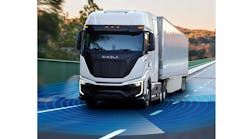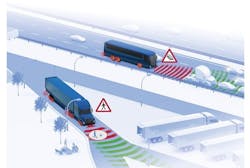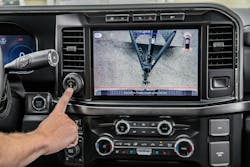This is Part One of a two-part story.
There’s no question that ADAS (advanced driver assistance systems) can improve road safety and fleet efficiency. Alone or as part of the whole, these mitigation and prevention systems enabled by sensors and AI, such as automatic emergency braking (AEB), adaptive cruise control, lane keep assist, and lane detection, provide backup to drivers who can and do make mistakes. They are only human, after all.
The scope of ADAS is also expanding, with AI literally able to back up trucks for the driver. Ford Pro’s Trailer Hitch Assist, for example, uses radar and cameras to judge the distance to the trailer, and the AI takes control of steering, acceleration, and braking to position the pickup’s hitch ball at the optimal spot to quickly couple.
ADAS advancements will only improve in the decade ahead, with the end goal of driverless trucks. If and when that happens at scale across the transportation industry is anybody’s guess, but for now, fleets are happy to reap the benefits from available ADAS.
“It’s making a positive difference for fleets and drivers every day,” said TJ Thomas, director of marketing and customer solutions—controls at Bendix Commercial Vehicle Systems, maker of heavy-duty ADAS solution Wingman Fusion. “Fleets equipping tractors with collision mitigation technologies have reported significant reductions in costs incurred from rear-end collisions—in some cases by more than 90%.”
And these results aren’t just talk. James Husted, director of maintenance at dry freight truckload carrier Garner Trucking in Findlay, Ohio, reported that his fleets saw a decrease in accidents when they installed AEB.
“Driver acceptance of ADAS is growing, and we know the investment is worth it,” Husted said. “At one point, we had a series of low-speed accidents, but since we started using automatic emergency braking, those incidents have been reduced by half. There is a cost for safer equipment, but it doesn’t matter when it comes to keeping drivers safe.”
For Phil Wilt, president/CEO at American Central Transport, a dry van truckload carrier in Kansas City, Missouri, with 300 tractors, ADAS technologies make a difference for new and experienced drivers alike.
“Anyone can have a bad day,” Wilt said. “These technologies can act faster than any driver and help prevent crashes. We’ve seen them make a difference. When injuries and damage are lower, everyone is safer.”
At Peterbilt, ADAS isn’t only seen as a way to mitigate the frequency and severity of collisions but as a way to help drivers’ overall performance.
“[ADAS technologies] also enable the driver to focus on operating the truck with maximum efficiency,” said Jacob White, director of product marketing, Peterbilt Motors.
While fleets have access to several safety systems, here are a few of the latest options, the fleets that use them, and the necessary maintenance practices that accompany ADAS.
Bendix Wingman Fusion
American Central Transport specs Bendix Wingman Fusion on its Kenworth T680 tractors. These provide collision mitigation, lane departure and assist, roll stability, and adaptive cruise control capabilities. American Central Transport’s tractors also have Lytx DriveCam systems with driver- and forward-facing cameras, and trailers are equipped with roll stability systems as well.
As of 2024, trucks with Bendix Wingman Fusion now have access to the system’s new features and enhanced capabilities, which include the Bendix FLR-25 Radar Sensor. Thomas explained that this enables Fusion to potentially detect pedestrians and offer collision mitigation capabilities such as autonomous emergency and stationary vehicle braking.
Built on the Bendix ESP full-stability system, Fusion can also provide full braking power on the tractor, along with pulsing air back to the trailer even if it doesn’t have an antilock braking/trailer roll stability unit.
Along with these new features, the latest Fusion system continues to provide multi-lane automatic emergency braking, highway departure warning and braking, Active Cruise with Braking, following distance alerts, lane departure warning, and alerts when speeding. The system also integrates with Bendix steering technologies like lane keep assist, active steering return, and road disturbance suppression.
Finally, the newest Fusion system has added the Stop & Driver Go and Auto-Resume features to Active Cruise with Braking. These allow the cruise control to resume after hitting the brakes, even to a stop, without having to reactivate the system. The latest Bendix Wingman Fusion also includes a new Service Brake Hold function, “which may hold the vehicle in place until the driver intervenes after an automatic braking event,” according to Bendix.
Read more: Product spotlight: ADAS tools
All of these features can be applied on many medium- and heavy-duty vehicles.
Since 2018, Wingman Fusion has come standard on Peterbilt Model 579s. For 2024, that has been enhanced to provide Active Cruise with Braking Stop & Driver Go functionality to aid drivers in heavy traffic situations, Peterbilt’s White noted. These additions complement a full suite of available ADAS features including lane keeping assist, side object detection, and AEB.
The new Peterbilt Model 589 also includes lane keeping assist, Active Cruise with Braking, side object detection, and AEB.
ZF’s OnGuardMAX and OnSideALERT
Launched for heavy-duty vehicles, the ZF OnGuardMAX automatic emergency braking system combines data integration with a camera and radar to detect, classify, and react to moving and stationary objects by warning drivers of obstructions in the vehicle’s path. The system can also automatically slow the vehicle down or bring it to a full stop.
ZF’s OnSideALERT is a radar-based detection system that continuously identifies stationary and moving objects in a vehicle’s blind spot.
According to Chuck Brodie, fleet service engineer, commercial vehicle solutions at ZF Group, OnGuardMAX for medium-duty vehicles will be rolled out this year and OnSideALERT in 2025. Both systems will be offered on vocational trucks in 2024.
“OnGuardMAX and OnSideALERT provide the same driver experience regardless of the vehicle,” Brodie related. “The only difference is that in some applications, depending on the OEM, ZF’s automatic cruise control may be included. Additionally, OnSideALERT will read the entire length of a tractor or medium-duty truck and the whole length of a combination when a trailer is attached.”
Detroit Assurance
For its 90 Freightliner tractors, Garner Trucking of Findlay, Ohio, specs the Detroit Assurance suite of safety systems, giving the fleet access to Detroit’s ABA5 features. The carrier also uses the SmartDrive driver, rear-facing cameras, and is considering adding rear backup cameras. Roll stability systems are also on all Garner trailers, and the company switched its fleet to disc brakes.
American Central Transport also specs Detroit Assurance on its Freightliner Cascadia tractors.
Detroit Assurance includes Active Speed Intervention, which works with Detroit’s Traffic Sign Display feature to issue alerts when a driver starts to speed, including passive and active warnings, de-throttling, and adaptive cruise control adjustment.
In addition, the system has the following features:
- Side Guard Assist, which alerts drivers of objects in their passenger-side blind spots. If the truck’s passenger side gets too close to a moving person or object, the system will warn the driver not to complete the right turn or make a right-hand lane change.
- Active Side Guard Assist, which engages at urban speeds (less than 12 mph) to prevent a truck from making a right turn into a moving cyclist or pedestrian.
- Active Brake Assist, which calculates truck speed and distance to other vehicles and determines if a warning or braking action is needed.
- Brake Hold Mode, which allows drivers to remove their foot from the brake pedal and keep their vehicle at a stop when sitting in traffic, at a weigh scale, or a loading dock.
- Adaptive Cruise Control, which automatically adjusts a truck’s cruising speed to maintain a safe following distance from other vehicles, including in stop-and-go traffic.
- Active Lane Assist, which uses camera and radar technology to improve low-speed maneuverability, reduce road vibrations, and increase ease of steering via micro-adjustments.
PlusDrive
Technology company Plus made a name for itself in 2019 when its Level 4 self-driving technology was used to perform the first autonomous cross-country freight delivery: 20 tons of butter for Land O’Lakes. The company’s PlusDrive technology is said to offer “Level 2++ supervised autonomy” and is the ADAS of choice for Nikola, which is expected to use the system on its Tre FCEVs (fuel cell electric vehicles) starting this year.
Read more: Kenworth offers new ADAS features on T680 trucks
Typical features include advanced lane centering, collision avoidance, and blind spot detection, though PlusDrive offers more sophisticated features as well, such as:
Nudging: If the AI detects a large vehicle passing or one stopped on the shoulder, it will nudge the vehicle it controls away to avoid an accident.
Traffic Jam Assist: This is the gridlock version of adaptive cruise control and matches other vehicles’ speeds and stops when needed in stop-and-go traffic.
Driver Initiated/Suggested Lane Change: If a disabled or slow-moving vehicle is ahead, PlusDrive can suggest and make lane changes upon the driver’s request.
Predictive Fuel Optimization: Manages braking and throttling based on road gradient and traffic to increase fuel/range efficiency by at least 10%.
Ford Pro ADAS
In addition to the usual ADAS features, Ford’s pickup drivers can also employ several assistive features to make work safer and easier. The Trailer Hitch Assist we previously mentioned comes in handy, especially when a user needs to swap out trailers several times in one day. Having the truck automatically get to the right spot to hitch up means they can spend more time on the actual job.
Ford also offers the Pro Trailer Backup Assist system to help maneuver vehicles into tight areas. The rear view appears on the infotainment screen, and the driver controls the vehicle’s movement using a dial on the dash to perform adjustments. The manufacturer also has a Tailgate Down Camera and Rear Park Aid Sensors to provide a rear view when backing up.
Managers can also activate in-cab coaching that detects harsh accelerating and speeding. Ford said the coaching had reduced harsh driving events by 80% and speeding by 75%.
To read about maintaining ADAS systems, continue to Part Two.






